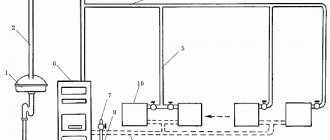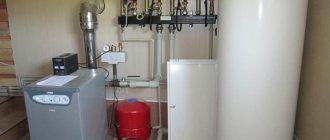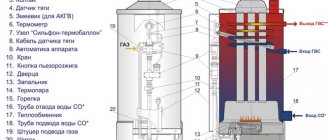What is a gas holder: general information
A gas holder is a container designed for long-term storage of natural gas or other gaseous substances (biogas, liquefied petroleum gas, air, etc.), but for heating purposes the tanks are filled with liquefied propane-butane. Gas holders are used both on an industrial scale and for private use.
This autonomous system is a large reservoir for storing gas reserves, which allows you to not depend on the state and independently regulate the amount of utility bills for gas supply. By refilling the container once or twice a year, depending on the volume of the tank, you can safely use a gas stove for cooking and heat the house.
Gas tanks vary in volume - from 2500 to 20,000 liters; small tanks are used for mobile gas tanks. Since these are devices that require increased attention, it is mandatory to install protective automation that monitors the gas pressure inside the tank, controls the distribution and amount of fuel, and is also responsible for the safety of the autonomous system. The gas holder, the photo of which is shown below, can provide gas to a large private house.
Horizontal gas tanks of large volumes Source resant.ru
Construction and design of a gas tank
Usually this container is made in the form of a single structure , the base of which is represented by fairly high-quality and durable steel sheets of large thickness.
The mandatory procedure that a finished gas holder undergoes is three-layer painting using paint containing epoxy resin. This allows you to make the structure more durable and provide protection from various types of damage. Finally, an anodic-cathodic protective coating is applied to the surface of the structure. Practical experience in using these tanks shows that they can be used for about 30-40 years . Moreover, during use there is no risk to life, since before sale they are necessarily subjected to tests, which confirm their suitability for use.
Types of gas tanks
Gas tanks have been used for private use for decades. Previously, they were very large, cylindrical structures with adjustable heights and were used to supply gas to entire areas in cities. Such systems are called gas holders of variable volume, and in some cities such buildings have been preserved to this day, albeit as museum exhibits.
What is a gas holder for a private home today? Modern versions of tanks are used mainly for gasification of private houses, summer houses, country cottages and have a more compact shape. They have a constant volume, are made of very durable metal and can be either vertical or horizontal. In addition, gas tanks are divided into above-ground and underground.
Installation of an underground gas tank Source resant.ru
Ground. Installed on the surface of the land. A gas holder for a ground-based private house is advantageous in that the tank is easier to maintain and it is much easier to detect corrosion or other changes and breakdowns. But we should not forget that with such an installation in winter, the evaporation ability of the air-gas mixture drops sharply; in addition, the ground version of the tank requires additional safety measures.
Ground-based small gas tank Source hvac-online.ru
First of all, you need to make sure that the container is not exposed to direct sunlight. Despite the fact that the tank body is designed to withstand high temperatures, for additional safety it is better to install the gas holder in the shade.
In order to significantly save space on the site, when choosing a ground-based gas tank, preference is given to vertical type tanks with a small volume, which are connected into a single network. From the point of view of operation, a vertical gas tank is in no way inferior. The photo below shows horizontal and vertical containers of different volumes.
Vertical and horizontal gas tanks Source resant.ru
Underground. At first glance, the underground installation of a gas tank is associated with additional costs, which consist in the need to attract special equipment. But the underground location of the system provides protection from the cold, additional safety and constant, even gas pressure.
To prevent freezing of the tank and avoid mechanical damage, underground gas tanks are buried to a depth of at least 60 cm. As for the volume of the tank, on the site of a country house or private house you can easily place a tank with a volume of 2500 to 10000 liters, and the gas tank will not spoil its appearance landscape design.
The tank is buried in the ground so that only the neck remains on the surface, to which the filling unit is connected. Gas enters the house through pipes running from the unit to the building.
Vertical underground gas tank at the installation stage Source teplowood.ru
See also: Contacts of construction companies that offer house insulation services.
Vertical. They are very similar to huge cans, and differ from horizontal ones in that they take up relatively little space on the site. But with high gas consumption, such tanks are additionally equipped with evaporators, which help provide the consumer with the required gas pressure. This makes installation noticeably more expensive and increases operating costs.
Thus, a vertical tank is only beneficial if the gas is used for cooking and providing the home with hot water in the summer, when relatively little is required. It should also be taken into account that vertical gas tanks are most often designed for underground installation, which means that high installation costs are added to low efficiency.
Installation of a vertical gas tank Source magniteknn.ru
Horizontal. They are considered the most common in our regions due to the fact that they have a large area for the evaporation of the so-called “liquid phase”. In the horizontal version of the gas tank there is always a sufficient amount of air-gas mixture, which is enough to ensure normal pressure at increased consumption. Therefore, to ensure proper evaporation, natural conditions are sufficient and no additional devices are required, and this is a big cost savings. Horizontal gas tanks are capable of providing sufficient pressure even in severe frosts. Only one drawback was found - installing such a tank will require a lot of space.
Installation of a horizontal gas tank Source pogreb-podval.ru
Mobile gas tanks
If the housing is not used constantly or there is not enough free territory to place a stationary device, it is reasonable to use a mobile gas holder. What are they and how are they used: this is also a gas supply device, only in small sizes, they are used as needed, for example during the summer season, and when it is not needed, it is simply stored.
Advantages:
- Such devices can provide gas to the premises during the summer season, and you can take them with you for the winter;
- It is possible to provide gas to several objects in turn;
- No special equipment or free territory on site is required for installation and assembly;
- Since the volume of a mobile gas storage is small (approximately 500-600 liters), its cost is correspondingly low.
All gas holders require registration with the relevant authorities and the mobile version is no exception.
Mobile gas tank or mini gas tank Source resant.ru
Underground installation of the system
Ensuring the supply of gas to the house is possible only if there is evaporation, which is ensured by the transition from a liquid to a gaseous state. The process of transition from one process to another directly depends on the immediate temperature of the gas and its environment. If the gas temperature is negative, then to ensure evaporation it is necessary to connect special installations, which is quite expensive.
The simplest and most rational solution in this case is to install the system in the ground at a level below its freezing point. Such a place often maintains a stable temperature throughout the year.
Features of underground vertical tank installation
- Most of the vertically located gas tank is always installed below the freezing point of the soil, which ensures a constant temperature of the substance and a stable process of its evaporation.
- Reservoirs are less susceptible to expulsion during low ambient temperatures.
- There are more options for installing the unit.
- The only disadvantages of such a system include the need to prepare a deep container, in which there is a small evaporation area.
Features of underground horizontal installation
- Quick preparation of the pit for installation of equipment.
- The evaporation mirror is of sufficient size to ensure full gas supply.
- The disadvantages of this arrangement include: the need for reliable fastening of the cylinder to prevent the system from being pushed out of the ground.
The procedure for installing an underground unit
To properly install an underground gas tank on the territory of a country house or uninhabited area, you must first prepare a pit, the bottom of which must be compacted in any acceptable way. The bottom of the pit is sealed according to the principle of a foundation (sand, gravel, concrete), which can later be used as a kind of anchor.
For more durable fastening of the gas tank to the concrete slab, specially made paws are used, which are installed at the factory according to individual orders. If the design of the tank does not provide for such benefits, then a connection of steel cables and loops pre-mounted to the concrete base can be used.
During the installation process, it is mandatory to install electrochemical protection of the gas tank from all kinds of corrosion, and install a container for collecting condensate.
Before direct backfilling, pressure testing of the gas supply system is carried out. It should be noted that the first layer of such backfill is carried out with fine sand, and all subsequent layers are filled with sorted soil.
Principle of operation
The principle of operation of a gas tank is quite simple: gas is pumped into a tank, and due to the fact that the tank is not completely filled, an air-gas mixture (propane-butane) is formed in the empty space of the storage. In order for the natural evaporation process to take place effectively, several rules should be followed:
- Do not fill the container with liquefied gas more than 85%.
- When installing a tank, it is necessary to strictly take into account that it should not be cooled below 0°, therefore, if a ground-based gas tank is installed, it will need to be insulated.
- If it is assumed that the evaporation area will be small (for example, in vertical containers), then it is necessary to consider an additional system of evaporators.
The gas mixture enters the house through a pipeline, just like through a regular pipeline. The gas tank is filled by specialists working on a machine with a filling tank. The procedure itself is reminiscent of refueling a car at a gas station.
The principle of operation of a gas holder in a private house
A system such as a gas tank operates on the following principle. Its main task is to accumulate liquefied gas under high pressure conditions. If there is a sufficient quantity, the latter is supplied through a gas pipeline to the distributors. From there it goes to the house and to the boiler and other devices that consume gas. In other words, the operation of this reservoir is carried out according to the same scheme as the main gas supply. When the entire gas supply in the tank is used up, it is filled with “blue fuel” again.
Video description
For more information about the gas tank and its installation, watch the video:
To control and regulate the process, the system has special automation; if you need to shut off the supply, you just need to turn a special tap. Excess pressure is removed using a special valve. The remaining gas is recorded thanks to a warning system that will warn the owner about the need to refill the tank.
Gas tank automation Source m.mitex-shop.ru
Volume calculation
Many people think that large-volume gas holders will save on heating costs. In fact, this is both right and wrong. The fact is that large tanks allow you to store significant reserves of fuel. In the spring, you can buy and pump gas into the tank at a minimal price, but with the arrival of the heating season, the cost of fuel increases.
The disadvantages of large gas storage facilities include: a huge volume of excavation work, the significant cost of such products and huge sums of money for the purchase of liquefied gas of the required volume. A large gas tank will take up a lot of space on the site, so let’s get acquainted with the nuances of calculating a gas storage using a specific example.
Tanks of different sizes
Let's say we have a house with an area of 200 m2. As we have already said, to heat such a building with liquefied gas, meet the need for hot water and other purposes, 27 liters of gas per year are consumed per square meter of usable area (for heating itself, no more than 20 l/m2). Based on these data, we will need a barrel with a volume of 5.4 m3.
Note! For our example, the tank capacity can be increased to 6m3. In this case, the owner of a country house will be able to refill the gas tank at a minimum cost of gas, and the fuel will last for the whole year.
How to install a turnkey gas tank
You need to order a turnkey gas holder for a private home only from a specialized company that has the necessary license. You cannot install a gas tank with your own hands - it is illegal.
The supply of gas to the tank, refueling, connection of the gas holder to the gas boiler and all service work must be carried out only by certified workers from special companies. This is explosive equipment and requires proper maintenance by qualified technicians.
Various volumes of vertical and horizontal gas tanks Source brickandpress.com
Preparatory stage
To properly install the gas tank, you must first carry out preparatory work. All dimensions of the pit and its location relative to the building must comply with the standards and requirements for the installation of gas tanks.
- The pit should be 0.5 m larger than the size of the tank on all sides.
- A concrete slab with fastenings for the tank feet is placed at the bottom of the pit.
- The trench under the highway should not interfere with or intertwine with other communications.
- The depth of the pipeline trench must be at least 1.70 m, and the slope towards the house must be at least 5°.
- The distance to a residential building from the gas tank is at least 10 m.
Delivery of the gas tank to the site for installation Source resant.ru
Selecting a location for installation
Installation of a gas tank in the private sector is an important undertaking, on which the performance and service life of the entire system fully depends. It should be noted that the progress of installation work depends solely on the type of equipment installation and the integrity of the tank
In this case, the location of the fuel storage tank itself in relation to the surface can be of 2 types: horizontal, vertical.
To ensure all safety standards, some requirements for installing a gas tank should be taken into account:
- The distance between the installation and residential premises must be more than 10 meters.
- The distance between the tank and industrial facilities must be more than 8 meters.
- The distance from the installation to outbuildings, garages or trees must exceed 5 meters.
- The distance between the water intake and the gas tank must be more than 15 meters.
- The distance between the container and the septic tank (storage well) must be more than 5 meters.
- The distance from the gas tank to local power lines should be one and a half heights of the support.
When installing a gas tank on a pre-developed area, changes may be made to the system installation criteria. However, to implement these, a conclusion from a qualified engineer on such a need is necessary.
Video description
For more information about autonomous gasification, watch the video:
If you want to buy a mobile gas tank, its price will be much cheaper than a regular one, and it will not require installation on site.
How to calculate the volume of a tank for a private house
Bigger does not mean better, so you need to calculate the volume of the gas tank correctly. This is done based on the technical characteristics of the heating boiler, the area of the house, and the number of cooking surfaces.
Horizontal gas tanks are selected with a margin of 15% of the calculated consumption indicators, and vertical ones with a margin of 10%.
Correct calculation of the tank volume allows you to choose a suitable gas tank for a private home; prices for them mainly depend on the volume, which means that you will not overpay for extra and unnecessary tank volume.
Installation diagram of a gas tank for heating a private house Source resant.ru
The cost of a gas tank and its installation
When choosing gas tanks for a private home, prices in the Moscow region can take a long time to review, since they depend both on the manufacturing company and on the volume of the tank itself. At first glance, everything is simple: the larger the tank, the higher the price, but the economic benefits of small storage facilities are sometimes deceptive. After all, a small tank needs to be refilled more often, which means additional costs for gas delivery. Therefore, you should choose a gas tank after first calculating the volume of the tank required for heating the house.
If you have already chosen and purchased a gas tank, the cost of installation will be calculated specifically for you by a specialist who comes to the work site. Typically, prices vary depending on the distance of the site from the city where the installation will take place, the size of the tank and its type, as well as the length of the gas pipeline. The cost of installation can vary from 40,000 to 100 thousand rubles. This includes everything (earth and installation work, reinforced concrete slab, set of materials, delivery), except the cost of the gas holder itself.
Installation of two gas tanks for heating a private house Source svoigaz.ru
Storage container
A gas tank is a container for storing gas, and in a specific situation of heating a country house, it is a container into which LPG, liquefied hydrocarbon gases, a mixture of butane and propane are poured. LPG is not at all the same gas that is supplied to houses through main gas pipelines - it uses methane-based fuel.
A gas holder differs from a conventional gas cylinder in size and stationarity; it is installed on the site for several decades and is periodically refueled from a special refueling machine. An underground gas pipeline is laid to the house from the reservoir (it must be at a certain distance), through which the evaporated gas flows to the boiler.
Gas tanks are made of steel and treated with special anti-corrosion compounds. The device is equipped with sensors that help control gas flow and indicate the pressure in the tank.
The history of gas holders began in 1781 in the laboratory of the French chemist Lavoisier. To store gas in his laboratory, he made a rectangular container with a capacity of 100 liters, and after a few years he realized that the gas holder should be cylindrical. Further, gas holders were used mainly in science, industry and urban utilities (for gas lamps).
Over time and the development of science, gas tanks changed, modified, and finally a variety appeared that is used for heating private houses. These are cylindrical tanks of constant volume that can withstand high pressure: there are tanks in which gas is stored at a pressure of up to 18 atm.
Advantages and disadvantages
The advantages of gas tanks for a private home include:
- optimal capacity of containers;
- independent workflow;
- safety for people living in the house;
- minimal financial costs;
- no waste after fuel combustion;
- For the system to work normally, it is enough to refill it two to three times within a year;
- The ability to configure the gas supply not only to the house, but also to individual appliances.
In addition, gas tanks for a private home also have certain disadvantages:
- the purchase of equipment, its installation and refueling will require significant expenses;
- an access road for refueling equipment will have to be provided to the reservoir;
- installing a vertical model will entail the use of electrical energy.
To minimize emergency situations and ensure uninterrupted operation of the gas tank, it is recommended to entrust its installation to professional specialists. Particular attention is paid to the integrity of the container and all its connections.
How to choose an evaporator?
When choosing an evaporator, you need to pay attention to the following details:
- Evaporator performance – cabinet units are more efficient than submersible units;
- Availability of space for installation - a cabinet evaporator needs a specially prepared site for installation, a submersible evaporator is mounted on a gas tank;
- At what stage is the evaporator installed? If the system is just being designed, then both options are suitable. For ready gas supply, only submersible evaporators can be installed.
When choosing performance, you need to take into account that if evaporators are mounted on separate gas tanks supplying fuel to a single system, then their performance is summed up in the future.
Tank installation options
Variations in the installation of gas tanks are limited in two ways:
- Surface installation.
- Installation underground.
For the first installation option, a characteristic condition is installation in places on the territory of a private farm, where the sun's rays penetrate to a small extent. A section of the territory is also selected that is, if possible, as protected as possible from the influence of external natural factors (strong wind, landslides, soil movements, etc.).
There are no specific requirements for the tank capacity. The volume of the gas tank is completely determined by the consumer needs and wishes of the owners of the country house.
A pit with a domestic gas holder immersed in it. The tank is secured with tape ties. The tank body is treated with a protective coating. Automation is mounted under the neck cover
Gas tanks of underground installation are mounted below the ground surface level. The tanks are deepened to a depth when the upper level of the vessel is at the deepening point at least 0.6 m from the ground surface level.
Only the filler neck of the tank remains at the same level with the ground surface or slightly higher. Under such deepening conditions, possible freezing of the tank in winter is excluded, plus the gas tank is reliably protected from possible mechanical influences.
Regardless of the type of installation, the location of gas tanks on a domestic site is allowed no closer than 10 meters from residential buildings and various technical communications.
The design for installing a tank for liquefied gas must provide easy, convenient approaches/entrances for gas refilling and maintenance. The presence of any utility lines in the immediate vicinity of the structure is not permitted.
The main design parameter for installation in a private household is the volume of the gas tank. According to the standards, the calculation is carried out with an emphasis on the square meter of usable area of the home. The average gas consumption figure for areas with a temperate climate does not exceed 35 m3 per 1 m2. From here you can calculate the approximate volume of the tank.
Standard parameters that should be used for installing gas tanks for domestic use. There may be some upward deviation from the standards, but it will be insignificant. Parameters directly depend on the size of the tanks
A more accurate volume figure is obtained if the calculation is based on the gas consumption of the heating boiler. Here, the rated power of the heating equipment is simply taken from the passport information and multiplied by the required gas consumption. Then the annual fuel requirement is calculated.
When performing calculations, you should take into account the fact that gas tanks are filled with liquid gas to no more than 85% of the tank volume.
Tank refill and gas price
The price of gas depends on the season. Market analysis shows that the minimum cost of fuel (from 14 rubles/liter) is typical for the spring-summer period. With the onset of cold weather, the price increases noticeably (up to 20 rubles/liter). Correct calculation of the required volume of the tank will allow you to save significantly due to its annual refueling at preferential prices.
fill the gas tank yourself - this is the work of specialists! The owner just needs to contact the appropriate company for services. Fuel is delivered to the storage facility on special vehicles - they are equipped with meters for monitoring the volume of fuel supplied. To make the correct calculation, the client only needs to check the meter readings at the start and end of the gas injection process.
If access to a gas tank is not possible, pumping is done using a hose. On average, the entire procedure takes about an hour and is absolutely safe for others.
Cabinet evaporation units
Cabinet-type evaporators are used when it is necessary to significantly increase the productivity of the installation. They have the general operating principle described above, but may differ in the type of heating element. So, heating can be done using:
- A heat exchange installation is the most reliable option;
- An electric heating element is easy to control, but there is a need to pay for associated costs and energy dependence appears;
- Gas heater - heating uses fuel from the system supplied to the burner, a simple and cheap option, but there is an obvious risk of fire or explosion if fuel leaks.
The equipment components are located in a cabinet with a locking mechanism. There are different options for climatic and vandal-proof design.











